How long does it take a tarantula to grow?

If you’re fascinated by tarantulas, you’re not alone. These spiders have captured the hearts of many around the world. Wondering how long it takes for them to grow is a common question. In this article, we’ll explore the journey of tarantula growth and the factors that influence it.
Tarantulas are known for their size and long lifespan, sometimes over 20 years. Their growth is a slow process, with many molts and stages. Learning about their growth can help you appreciate them more and care for them better. So, let’s discover how long it takes for a tarantula to grow and the interesting details of their development.
Understanding the Tarantula Growth Process
Tarantula growth is a complex process centered on the tarantula molting process. Molting, or shedding the exoskeleton, lets the spider grow bigger. Knowing what affects tarantula growth is key to their care and healthy growth.
Tarantula Molting: The Key to Growth
The tarantula growth process relies on molting. As the tarantula gets bigger, its shell gets too small. It must shed its old shell to grow.
During molting, the tarantula pulls back into its new, larger shell. This is how it grows.
Factors Affecting Tarantula Growth Rate
Several factors can change how fast a tarantula grows. These include:
- Species: Different tarantulas grow at different rates and reach different sizes.
- Diet: A good diet is vital for the tarantula’s growth process.
- Temperature: The right temperature helps with healthy molting and growth.
- Humidity: The right humidity levels also affect the molting process and growth.
| Factor | Impact on Tarantula Growth |
|---|---|
| Species | Certain species, like dwarf tarantulas, grow slower than larger ones. |
| Diet | A diet full of proteins and nutrients supports healthy tarantula growth. |
| Temperature | Temperatures between 70-80°F (21-27°C) help with the tarantula molting process and growth. |
| Humidity | Humidity levels between 60-80% help the tarantula molt and grow well. |
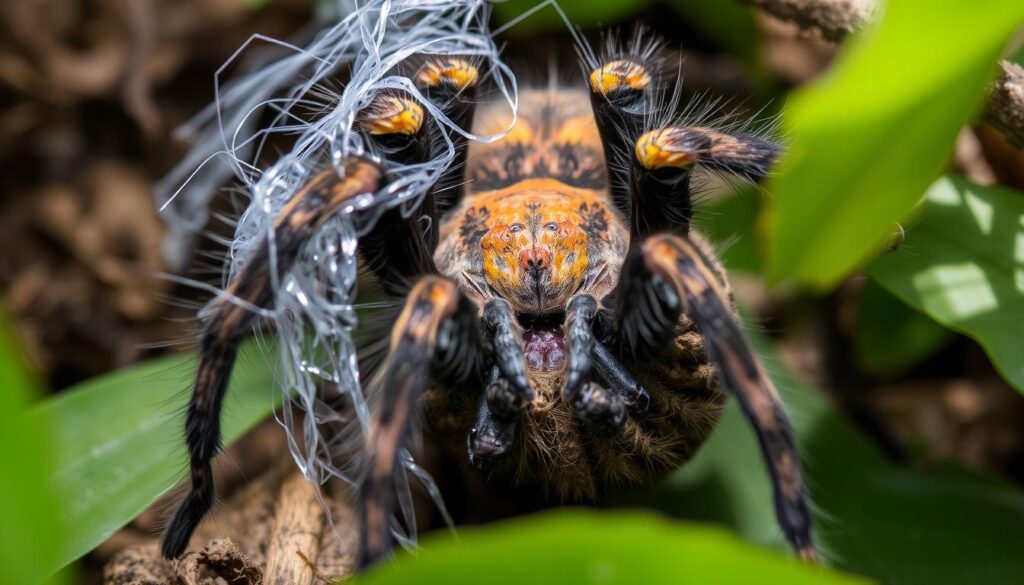
How Long Does It Take a Tarantula to Grow?
The journey of a tarantula’s growth is truly captivating. The exact time can vary by species and environment. Yet, there are patterns that give us a glimpse into their growth.
Most tarantulas reach their full size in 1 to 5 years. Some grow faster, in just 6 months. Others may take up to 10 years. Growth depends on temperature, humidity, and food availability.
Here are some key milestones in a tarantula’s growth:
- Sling Stage: New tarantulas, or slings, grow fast in their first months. They can double or triple in size.
- Juvenile Stage: As they grow, tarantulas molt several times. This lets their bodies grow bigger.
- Adult Stage: Once they reach adulthood, their growth slows. They focus on keeping their size and energy.
The tarantula growth timeline shows their amazing adaptability and resilience. It’s fascinating to see how they change as they grow. Understanding their growth helps us appreciate their incredible transformations.

Tarantula Growth Stages
Tarantulas go through three main growth stages: sling, juvenile, and adult. Each stage has its own look and behavior. These changes show how amazing tarantulas are.
Sling Stage
The sling, or spiderling, is the first stage of a tarantula’s life. It’s tiny, with a soft, clear shell. The sling grows by shedding its skin several times.
Juvenile Stage
When the sling grows up, it becomes a juvenile. It starts to look more like a tarantula. Its colors and patterns show what species it is. Juveniles are very active and learn how to hunt.
Adult Stage
Finally, the tarantula becomes an adult. It’s the biggest and most impressive stage. Adults can be quite large, with thick, hairy legs. They are less active, focusing on breeding and defending their territory.
Knowing about tarantula growth stages helps us care for them better. By understanding their changes, we can give them the best life. This ensures they grow healthy and happy.

Tarantula Size and Lifespan
Tarantulas vary greatly in size, from tiny dwarfs to huge giants. Their size and lifespan depend on the species. Let’s dive into the amazing differences in tarantula size and lifespan.
The Green Bottle Blue Tarantula lives for 10 to 15 years for females and 3 to 6 years for males. Adult males are about 4 to 5 inches wide, while females can grow up to 6 to 7 inches.
 Discover the Fascinating World of Theraphosidae
Discover the Fascinating World of Theraphosidae
The Orange-kneed Tarantula is known for its bright look. Females can grow up to 6 inches wide, and males are about 4 inches. These tarantulas can live up to 10 to 20 years, with the right care extending their life even more.
The Tiger Rump Tarantula is a bit smaller, with males reaching 4 to 5 inches and females up to 6 inches. But they live a long time, up to 10 years in captivity, and some can live up to 15 years.

These examples show the amazing variety in tarantula size and lifespan. Even the smaller species can live a long time. This shows how resilient and adaptable these fascinating creatures are.
Variations in Tarantula Growth Among Species
Tarantulas come in all sizes, from the tiny Damon diadema to the massive Theraphosa blondi. Knowing these differences is key for those who keep tarantulas as pets. It helps in providing the right care and managing what to expect.
Dwarf Tarantulas
Dwarf tarantulas, like the Damon diadema, are small. They have a leg span of 4.5 to 5.5 inches and weigh 2 to 3 ounces. They can live up to 5 years for males and 20 years for females in the wild and captivity.
Giant Tarantulas
Giant tarantulas, like the Theraphosa blondi, are huge. They can have a leg span over 10 inches and weigh several ounces. Despite their size, they live as long as their smaller cousins, up to 5 years for males and 20 years for females.
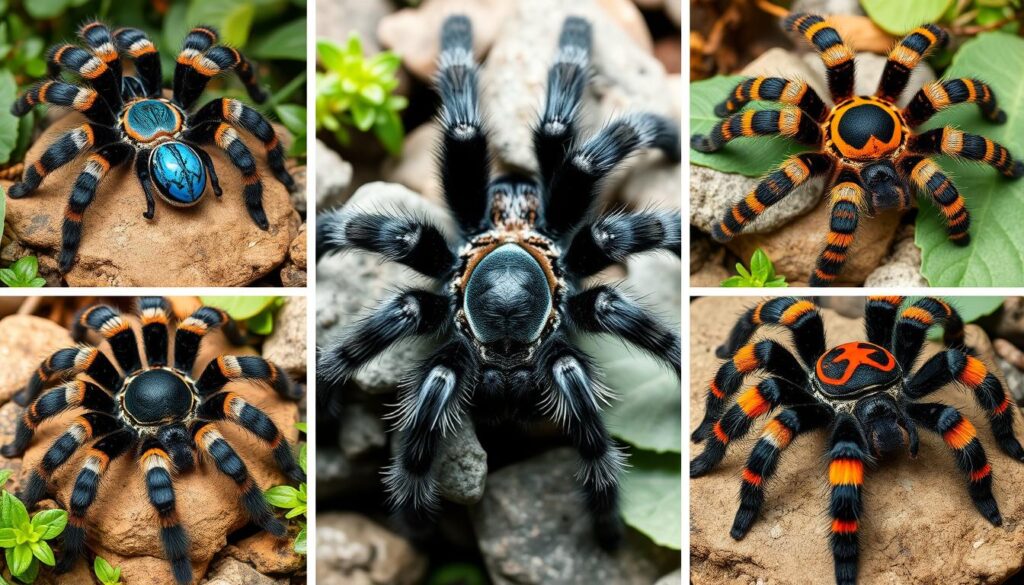
It’s important to know the size and growth differences among tarantulas. This knowledge helps in creating the right environment and care for these amazing creatures. By understanding each species’ unique traits, tarantula enthusiasts can help their pets live a happy and healthy life.
Providing Optimal Conditions for Tarantula Growth
To help your tarantula grow well, you need to give it the right environment. This means keeping the temperature and humidity levels just right. Also, make sure it has a good diet and water. By getting these things right, you can really help your tarantula grow and stay healthy.
Temperature and Humidity Requirements
Tarantulas need heat from outside to keep their body warm. The best temperature for them is between 70°F and 85°F (21°C and 29°C). They also need humidity between 60% and 80% to stay hydrated and healthy.
Feeding and Watering Habits
Feeding and watering your tarantula right is also important. They should eat a mix of food like crickets, mealworms, or small mice, depending on their type. Don’t overfeed them, as it can harm their health. Also, they need a shallow water dish to drink from.
By watching and adjusting the temperature, humidity, and food and water, you can make a great home for your tarantula. This care will help your pet stay healthy and happy for a long time.
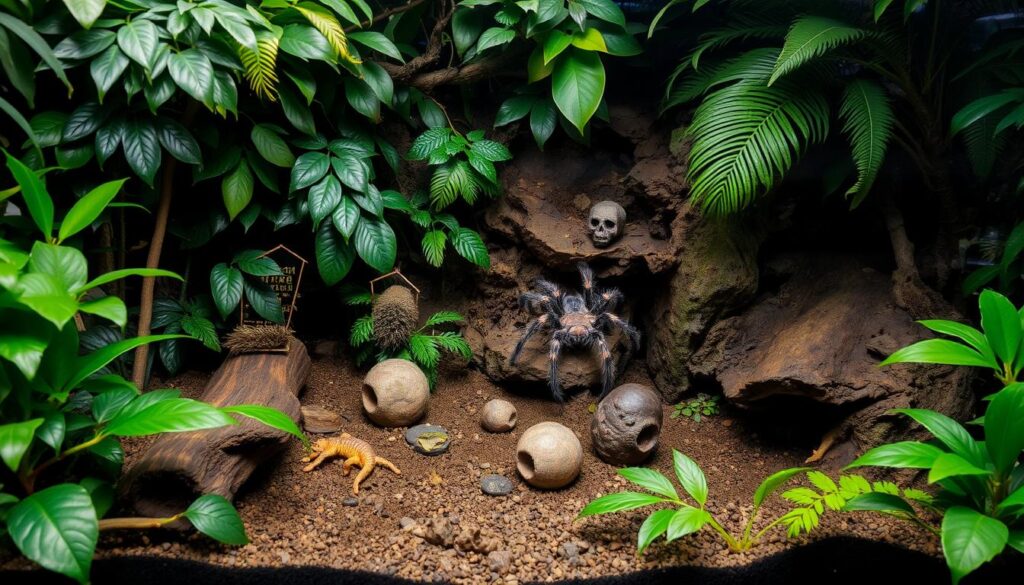
Signs of a Healthy, Growing Tarantula
It’s important to know the signs of a healthy, growing tarantula. This helps you see how they’re doing and spot any problems early. By watching for certain physical and behavioral signs, you can check on your tarantula’s health and make good care choices.
One key sign of healthy tarantula growth is molting. Tarantulas shed their skin to grow bigger. This is a big sign that your tarantula is getting bigger and healthier. Make sure they have a clean, safe place to molt.
- Vibrant, well-groomed appearance
- Active and responsive behavior
- Consistent appetite and regular feeding
- Clear, unobstructed molting process
- Gradual increase in size and body mass
A healthy, growing tarantula also shows good behavior. They should be lively, alert, and react well when you touch or watch them. They should also eat regularly and enjoy their food.
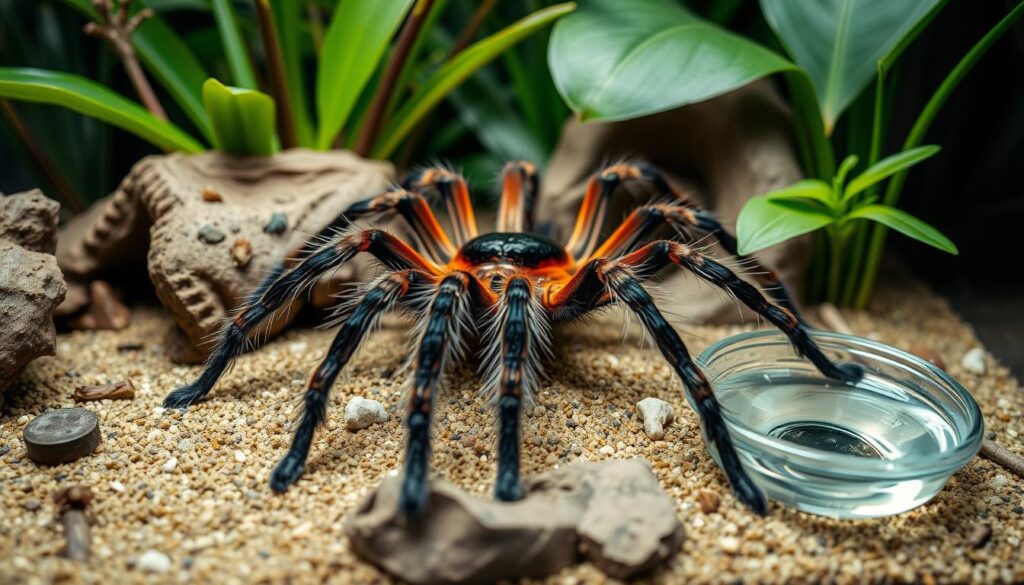
Watching your tarantula’s growth indicators closely is key. This way, you can make sure they’re growing right and fix any problems fast. Watching your tarantula grow is exciting, and knowing the signs of a healthy one helps you care for them better.
Tarantula Care: Ensuring Proper Growth
Proper care and the right environment are key for a tarantula’s growth. To help your tarantula grow well, we’ll look at habitat setup, feeding, and controlling humidity and temperature.
Crafting the Perfect Tarantula Habitat
A good habitat is the base for a happy tarantula. Choose a well-ventilated enclosure for temperature and humidity control. Add hiding spots, substrate, and decor that match their natural home. Choosing the right habitat is vital for your tarantula’s growth and health.
 Discover Spiders in Australia: Your Arachnid Guide
Discover Spiders in Australia: Your Arachnid Guide
Feeding and Hydration Habits
Tarantulas eat insects like crickets, roaches, and grasshoppers. Give them a balanced diet and clean, fresh water. Don’t overfeed, as it can harm their health and growth. Stick to a regular feeding schedule to help them grow.
Temperature and Humidity Control
Tarantulas need the right temperature and humidity for growth. Keep the temperature between 75-85°F (24-29°C) and humidity at 50-60%. Watch these levels closely and adjust them to make the best habitat for your tarantula.
By following these care tips, you can help your tarantula grow and stay healthy. Remember, each tarantula species has its own needs. So, it’s important to learn about your tarantula’s specific care requirements.
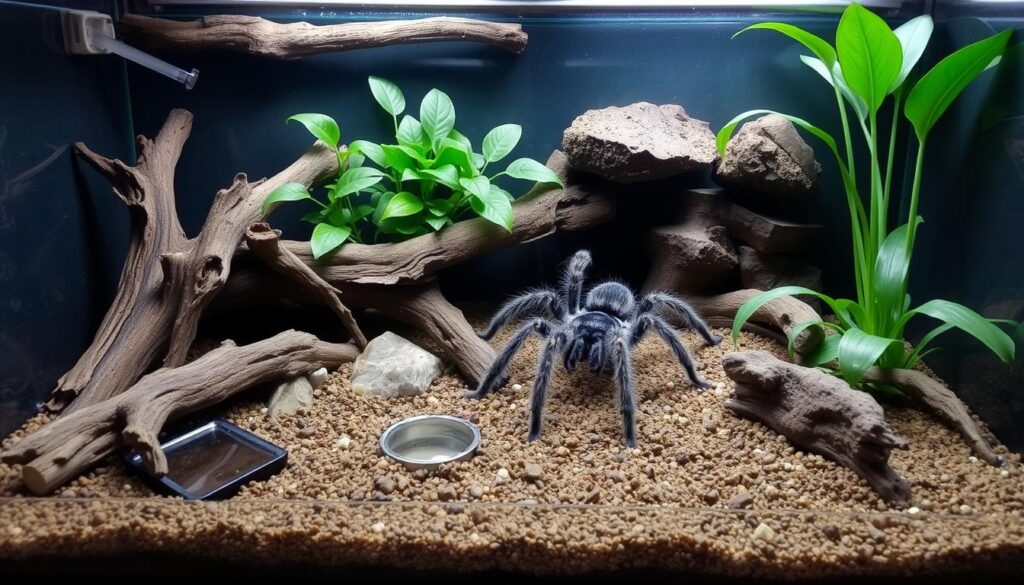
Troubleshooting Common Growth Issues
As a tarantula owner, you might face growth-related challenges. These can include molting difficulties or health problems. Knowing about these issues can help you solve them quickly and keep your tarantula healthy.
Tarantula Molting Struggles
Molting is key for tarantula growth, but it can be tough sometimes. If your tarantula has trouble shedding its skin, it might be due to wrong humidity, not enough substrate, or health issues. Watching your tarantula closely and making sure its environment is right can help with molting problems.
Identifying and Addressing Health Problems
Tarantulas can have health issues that affect their growth. Signs of tarantula growth problems include being very tired, not wanting to eat, or acting strangely. These could be because of bad feeding, not enough water, or the wrong environment. Regular checks and talking to a vet can help spot and fix tarantula health problems fast.
| Common Growth Issues | Potential Causes | Recommended Solutions |
|---|---|---|
| Molting Difficulties | – Improper humidity levels – Inadequate substrate depth – Underlying health concerns |
– Maintain optimal humidity – Provide sufficient substrate depth – Consult with a vet |
| Lethargy and Loss of Appetite | – Improper feeding and hydration – Environmental factors |
– Adjust feeding and watering regimes – Ensure proper temperature and humidity |
| Abnormal Behavior | – Stress factors – Underlying health issues |
– Minimize disturbances – Consult with a vet |
By being proactive and tackling tarantula growth problems and health issues quickly, you can help your tarantula grow well and enjoy its fascinating journey.

Tarantula Growth: A Fascinating Journey
Watching a tarantula growth journey is truly captivating. From a tiny spiderling to a majestic adult, it’s amazing. These arachnids change a lot as they grow, showing us the wonder of tarantula development. Let’s dive into the incredible changes these creatures go through.
Tarantulas start as tiny spiderlings, often smaller than a penny. These young ones, called slings, molt several times to grow. With each molt, they get bigger and their features become clearer.
- Slings molt many times in their first year, growing fast and getting their iconic look.
- As they get older, tarantulas molt again, improving their colors, patterns, and leg length.
- When they reach adulthood, they molt one last time, reaching their full size and sexual maturity.
The tarantula growth journey isn’t just about molting. Things like temperature, humidity, and diet also matter. These factors help shape the tarantula development and growth rate. Knowing this helps us appreciate tarantulas’ adaptability and resilience.

Seeing a tiny spiderling turn into a majestic adult tarantula is incredible. This tarantula growth journey teaches us a lot about these fascinating arachnids. By exploring their development, we can discover the amazing world of tarantulas.
Captive vs. Wild Tarantula Growth Rates
There are big differences in how tarantulas grow in captivity versus in the wild. Knowing these differences helps us care for them better and protect their habitats. Let’s look at what makes captive and wild tarantulas grow at different rates.
Captive tarantulas, like the Green Bottle Blue Tarantula, grow faster than wild ones. They get plenty of food, the right temperature and humidity, and no predators. This lets them grow quickly. For example, female Green Bottle Blue Tarantulas in captivity can live up to 15 years and grow to 5 inches in leg span. Males live 3 to 6 years and grow to 4 to 5 inches.
Wild tarantulas, however, face many challenges. They must find food, deal with changing weather, and avoid predators. These issues slow their growth. The Blue-fang Tarantula, for example, takes years to grow up, reaching 6 to 8 inches in leg span. Wild Chilean rose tarantulas live up to 20 years for females and 5 years for males, showing their slower growth.
It’s important to balance caring for captive tarantulas with protecting their natural habitats. Captive breeding helps some species, but we must also protect their homes. By understanding how captive and wild tarantulas grow, we can help these amazing creatures thrive for years to come.
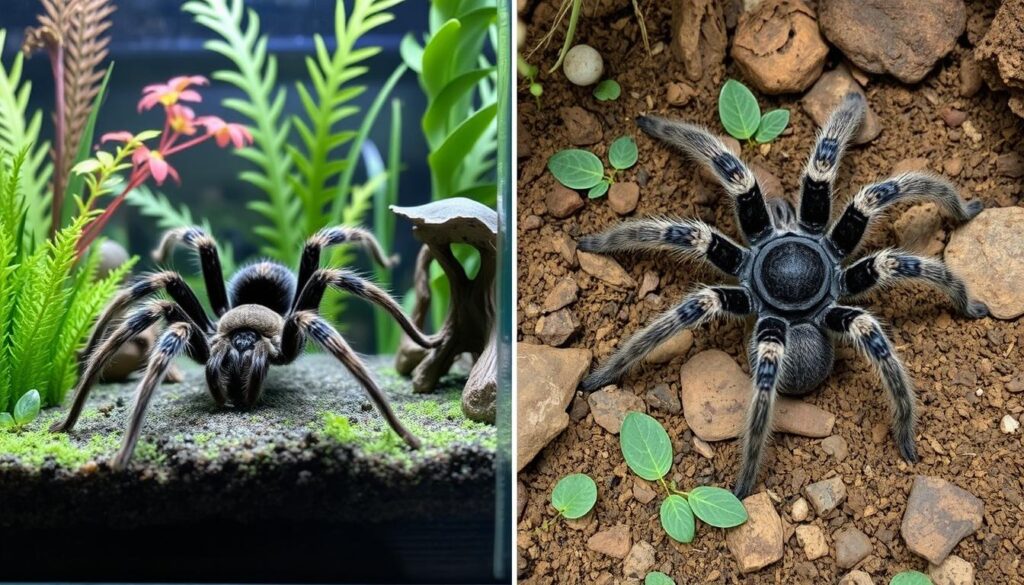
Tarantula Growth Records and Curiosities
In the world of tarantulas, there are amazing growth records and curiosities. The largest known tarantulas can have leg spans of up to 11 inches. They can even weigh as much as a young puppy. These huge spiders, called Goliath Birdeaters, are the heaviest spiders alive. They can live up to 25 years in captivity.
Tarantulas grow slowly, but sometimes they surprise us with fast growth. The Jewfish, for example, can grow up to 8 feet long and weigh over 800 pounds. While not tarantulas, their size is fascinating and adds to the interest in tarantula growth facts.
 Tarantula Babies on Back: What You Need to Know
Tarantula Babies on Back: What You Need to Know
Beyond size, unusual tarantula growth can show in other ways. Some tarantulas have unique colors or behaviors. These tarantula growth records show how diverse and adaptable these creatures are. They inspire us to keep exploring the natural world’s wonders.



